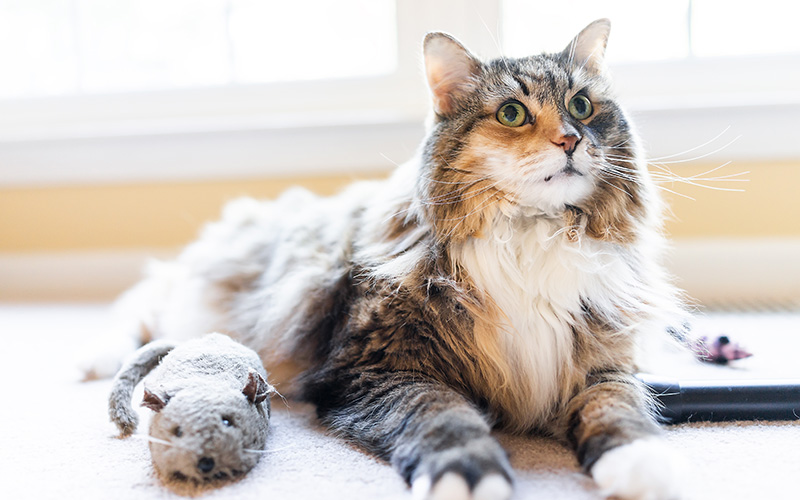Many pet cats are overweight or obese. According a survey conducted in 2018 by the Association for Pet Obesity Prevention, an estimated 60% of cats in the United Sates are overweight or obese. That translates into 56 million cats in the US alone. About 10% of cats seen in veterinary clinics are overweight, leaving the other 40% to fall into the obese category.
What is the difference between being overweight and being obese? Any cat that is over its ideal weight is considered overweight. The usual definition of obesity is when a cat is about 20% over its ideal weight. For example, if your cat weighs 10 pounds, then 12 pounds is considered obese. Many will comment, “but it’s only 2 pounds!” And indeed, 2 pounds on an adult human is not significant. But on a 10-pound cat, it is! For humans, this would be like a 150-pound person carrying an extra 30 pounds.
Because cats come in all different sizes and weights, there is no “magic number” that you can use to tell if your cat is at its ideal weight. Veterinarians use a five-point or nine-point scoring system (“Body Condition Score”) to assess a cat’s weight status. A score of 2.5 – 3 on the five-point scale or 4.5 – 5 on the nine-point scale indicates that a cat is at its ideal weight, whereas a score of 5 or 9 means that a cat is severely obese. A severely skinny cat would have a score of 1.
An overweight or obese cat can experience a number of health problems caused by the extra weight, including diabetes, arthritis, high blood pressure, respiratory disorders, liver disease, and a decreased immune response. For the health and longevity of your cat, it is important to prevent obesity in your cat. Here are seven tips to help keep cats at a healthy weight:
1. Choose the best food
It is important that the food you feed your cat is providing all the nutritional requirements for your cat’s life stage. For example, kitten food should not be fed to a senior cat. Senior cats may do better with a calorie-reduced diet that still supplies all the nutrients they need. Kittens, on the other hand, need a diet that has all the nutritional requirements that will help them grow. Speak to your veterinarian for recommendations on the best diets for your cat.
2. Avoid free feeding
Free feeding (leaving a bowl of dry food available to a cat to feed from all day) is a contributing factor to obesity in cats. Many cat owners use free feeding for convenience, but cats can consume excessive amounts of food when fed in this manner.
3. Consider a switch to canned food
Switching to canned food encourages “meal feeding” rather than free feeding with dry food. Canned food typically has a higher protein content and lower carbohydrate levels than most kibble diets. Discuss this option with your veterinarian to determine if canned food would be a good option for your cat.
4. Measure the food
With the help of your veterinarian, determine how much food your cat actually needs based on your cat’s activity level and ideal weight. Once you know how much food your cat needs, measure or weigh the food for each meal. Remember, cats are small, and the portion may look tiny to you, but a few extra kibbles can mean the difference between weight maintenance and weight gain. Using a smaller feeding dish may help you feel that the meals you are feeding to your cat aren’t so tiny! Feed your cat the appropriate number of meals per day based on your veterinarian’s recommendations.
5. Avoid treats
Eliminate treats or use them sparingly as rewards when training or for administering medication. Many cooked vegetables make good treats for cats. Ask your veterinarian for recommendations on the most appropriate treats for your cat. When you’re providing more treats than usual, cut back on your cat’s regular food portion that day.
6. Encourage exercise
To avoid obesity, include exercise in your cat’s daily routine. Play with your cat for about 5 minutes several times a day. Play not only helps burn calories, but it also relieves boredom and keeps your cat in good physical condition. Try playing interactive games with your cat such as pounce games with a feather on a wand or roll balls for your cat to chase. Consider a scratching post that will encourage your cat to climb and stretch her muscles.
7. Weigh your cat
Sometimes it’s hard to see increases in your cat’s weight, and gradual increases over time are easy to miss. Consider weighing your cat once a week to make sure weight isn’t sneaking on. If your cat likes to go in her carrier, use the carrier to help you. Weigh the carrier first, then place your cat in her carrier and weigh the two together. Now subtract the weight of the carrier from the weight of the carrier plus your cat. Alternatively, weigh yourself first, then hold your cat and weigh the two of you together. Now subtract your weight from the weight of you plus your cat. Keep in mind that most household scales are generally marked in pounds and are not highly accurate for fractions of a pound. Your veterinarian will have more accurate scales, and if you are trying to reduce your cat’s weight, regular weigh-ins at the clinic may be recommended. Alternatively, it may be well worth it to purchase a digital scale that is more sensitive and able to report in tenths of pounds.
If you have recognized that your cat is overweight or obese, seek the help of your veterinarian. By simply reducing the amount of food or restricting her diet can cause serious health problems for your cat. The weight must be lost gradually over time. It’s never too late to reduce your pet’s weight and improve your pet’s health.






